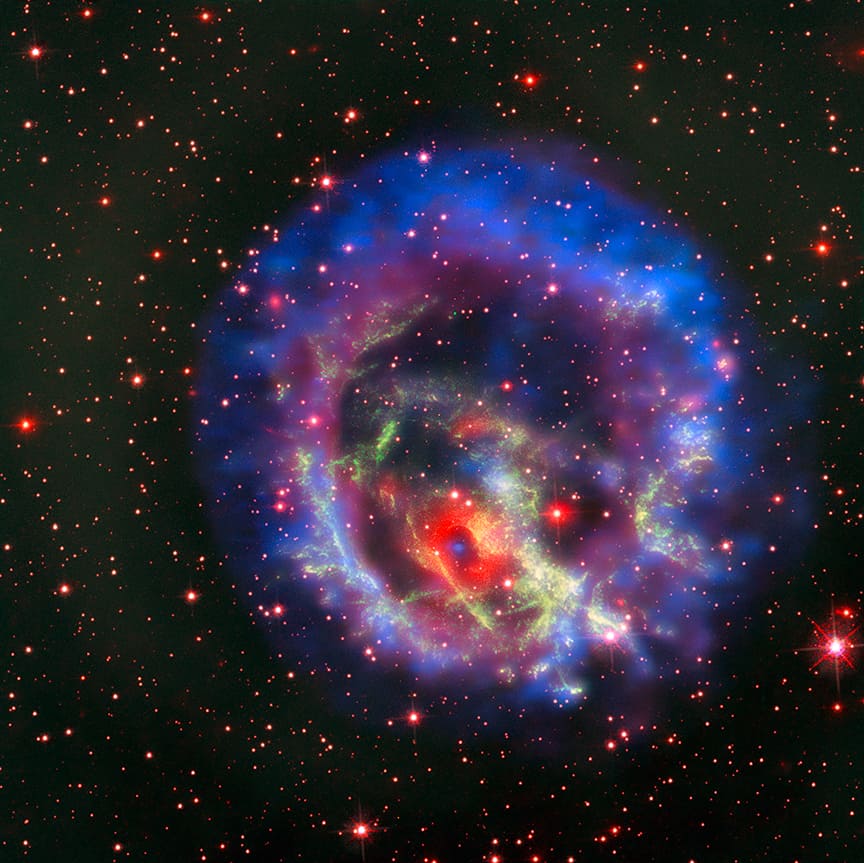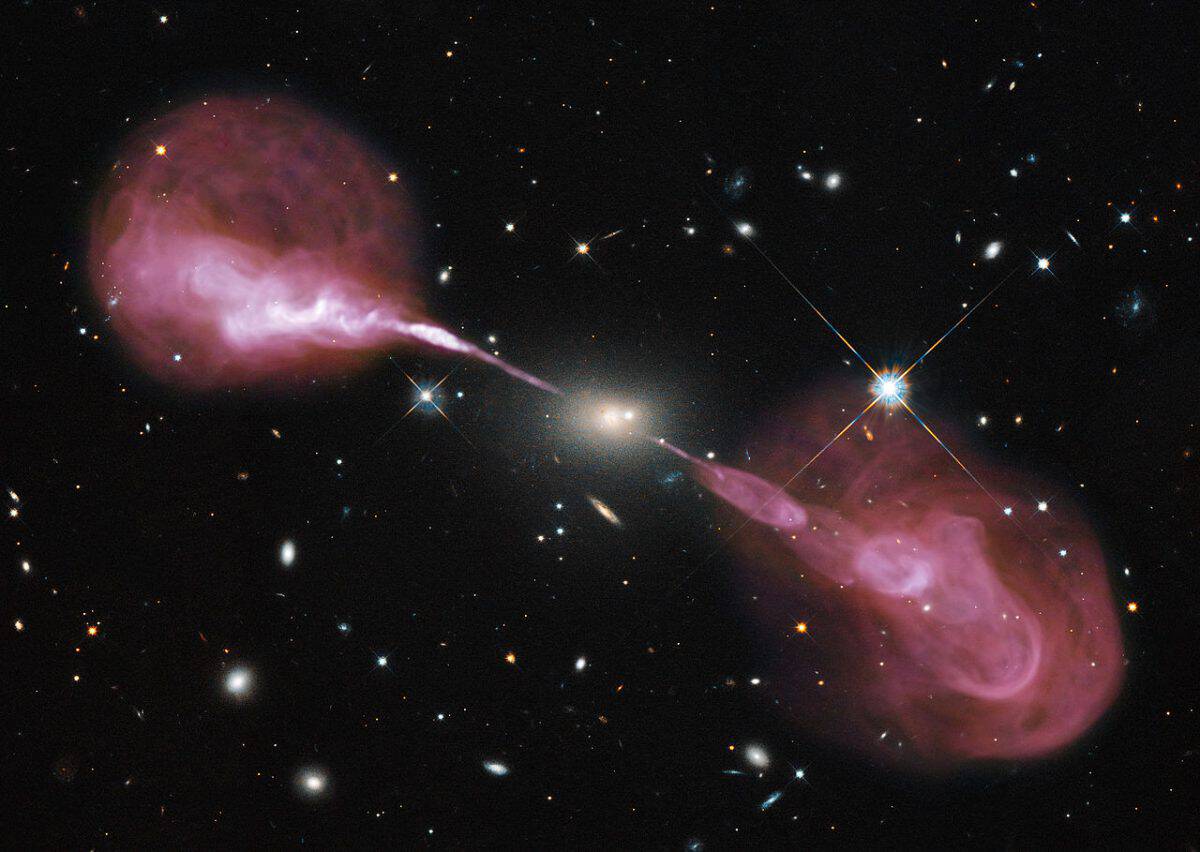Blog
Hercules A is a bright astronomical radio source within the vicinity of the constellation Hercules corresponding to the galaxy 3C 348.
During a survey of bright radio sources in the mid-20th century, astronomers found a very bright radio source in the constellation Hercules. The radio source is strongest in the middle range frequency and emits synchrotron radiation, suggesting the source of radio emission may be gravitational interaction. In 1959, astronomers from the Radio Astronomy Group (later the Cavendish Astrophysics Group) detected the radio source using the Cambridge Interferometer of the Cavendish Observatory in Cambridge University in United Kingdom, including it in the Third Cambridge Catalogue of Radio Sources (3C) as 3C 348, the 348th object detected by the survey.
The galaxy, 3C 348, is a supergiant elliptical galaxy. It is classified as type E3 to E4 of the updated Hubble-de Vaucouleurs extended galaxy morphological classification scheme. Little else is known about the galaxy.
3C 348, the galaxy at the image center, appears to be a relatively normal elliptical galaxy in visible light. When imaged in radio waves, however, plasma jets over one million light years long appear. Detailed analyses indicate that the galaxy is actually over 1,000 times more massive (approx. 1015 solar masses) than our Milky Way Galaxy, and the central black hole is nearly 1,000 times more massive (approx. 4 billion solar masses) than the black hole at our Milky Way’s center, one of the largest known. The physics that creates the jets is poorly understood, with a likely energy source being matter ejected perpendicular to the accretion disc of the central black hole.
more...John Lester “Johnny” Nash, Jr. (born August 19, 1940) is an American reggae and pop music singer-songwriter, best known in the US for his 1972 hit, “I Can See Clearly Now“. He was also one of the first non-Jamaican singers to record reggae music in Kingston, Jamaica.
Born John Lester Nash, Jr. in Houston, Texas, he began as a pop singer in the 1950s. He released four albums for ABC-Paramount, with his self-named debut in 1958. Around 20 singles were released between 1958 & 1964 on a variety of labels such as Groove, Chess, Argo and Warners. He also enjoyed success as an actor early in his career, appearing in the screen version of playwright Louis S. Peterson‘s Take a Giant Step. Nash won a Silver Sail Award for his performance from the Locarno International Film Festival.
more...Peter Edward “Ginger” Baker (born 19 August 1939) is an English drummer and the founder of the rock band Cream. His work in the 1960s earned him the reputation of “rock’s first superstar drummer,” while his individual style melds a jazz background with African rhythms. Baker is credited as a pioneer of drumming in genres like jazz fusion, heavy metal and world music.
Baker began playing drums at age 15, and later took lessons from Phil Seamen. In the 1960s, he joined Blues Incorporated, where he met bassist Jack Bruce. The two clashed often, but would be rhythm section partners again in the Graham Bond Organisation and Cream, the latter of which Baker co-founded with Eric Clapton in 1966. Cream achieved worldwide success but lasted only until 1968, in part due to Baker’s and Bruce’s volatile relationship. After briefly working with Clapton in Blind Faith and leading Ginger Baker’s Air Force, Baker spent several years in the 1970s living and recording in Africa, often with Fela Kuti, in pursuit of his long-time interest in African music. Among Baker’s other collaborations are his work with Gary Moore, Masters of Reality, Public Image Ltd, Hawkwind, Atomic Rooster, Bill Laswell, jazz bassist Charlie Haden, jazz guitarist Bill Frisell and Ginger Baker’s Energy.
Baker’s drumming is regarded for its style, showmanship, and use of two bass drums instead of the conventional one. In his early days, he performed lengthy drum solos, most notably in the Cream song “Toad“, one of the earliest recorded examples in rock music. Baker is an inductee of the Rock and Roll Hall of Fame as a member of Cream, of the Modern Drummer Hall of Fame in 2008, and of the Classic Drummer Hall of Fame in 2016.
more...James George Hunter (August 19, 1918 – May 28, 1996), known professionally as Jimmy Rowles, was an American jazz pianist, vocalist, and composer. As a bandleader and accompanist, he explored various styles including swing and cool jazz.
Rowles was born in Spokane, Washington and attended Gonzaga College (now University) in Spokane. After moving to Los Angeles, he joined Lester Young‘s group in 1942. He also worked with Benny Goodman, Woody Herman, Les Brown, Tommy Dorsey, Tony Bennett, and as a studio musician.
more...From Finland
more...
A composite image of the supernova 1E0102.2-7219 contains X-rays from Chandra (blue and purple), visible light data from VLT’s MUSE instrument (bright red), and additional data from Hubble (dark red and green). A neutron star, the ultra dense core of a massive star that collapses and undergoes a supernova explosion, is found at its center.
Oscar Brashear (born August 18, 1944, Chicago, Illinois) is an American jazz trumpeter and session musician.
After studying at DuSable High School and Wright Jr. College under John DeRoule he worked briefly with Woody Herman before going on to join Count Basie ’68-9, returning to freelance in Chicago with Sonny Stitt, Gene Ammons, Dexter Gordon and James Moody. Moving to Los Angeles in 1971, he worked with Gerald Wilson, Harold Land, Oliver Nelson, Shelly Manne, Quincy Jones (with whom he toured in Japan), Horace Silver and Duke Pearson.
Brashear has recorded with Teddy Edwards, Jimmy Smith, Sonny Rollins, Benny Golson, Bobby Hutcherson, B. B. King, Bobby Bland, Freddie Hubbard, Joe Farrell, The Crusaders, McCoy Tyner, Gene Harris, Randy Newman, Frank Sinatra, Earth, Wind & Fire, Carole King, Benny Carter, Billy Higgins and Ry Cooder.
more...Enoch Henry Light (18 August 1905, in Canton, Ohio – 31 July 1978, in Redding, Connecticut) was a classically trained violinist, danceband leader, and recording engineer. As the leader of various dance bands that recorded as early as March 1927 and continuing through at least 1940, Light and his band primarily worked in various hotels in New York. For a time in 1928 he also led a band in Paris. In the 1930s Light also studied conducting with the French conductor Maurice Frigara in Paris.
Throughout the 1930s, Light and his outfits were steadily employed in the generally more upscale hotel restaurants and ballrooms in New York that catered to providing polite ambiance for dining and functional dance music of current popular songs rather than out and out jazz. (It must be remembered that at the time there was always some crossover between popular and jazz music and that the most successful bandleaders frequently played a mixture of both to some extent in order to cater to the demands of their audiences, although the bands employed in swank hotel ballrooms were generally far more subdued in nature.)
At some point his band was tagged “The Light Brigade” and they often broadcast over radio live from the Hotel Taft in New York where they had a long residency. Through 1940, Light and his band recorded for various labels including Brunswick, ARC, Vocalion and Bluebird. Later on, as A&R (Artists and Repertoire) chief and vice-president of Grand Award Records, he founded his own label Command Records in 1959. Light’s name was prominent on many albums both as musician and producer.
more...Fela Anikulapo Kuti (15 October 1938 – 2 August 1997), also professionally known as Fela Kuti, or simply Fela, was a Nigerian multi-instrumentalist, musician, composer, pioneer of the Afrobeat music genre and human rights activist. He has been called “superstar, singer, musician, Panafricanist, polygamist, mystic, legend.” At the height of his popularity, he was referred to as one of Africa’s most “challenging and charismatic music performers.
more...https://www.youtube.com/watch?v=FktqOli6Hq4
more...New observations with ESO’s Very Large Telescope show the star cluster RCW 38 in all its glory. This image was taken during testing of the HAWK-I camera with the GRAAL adaptive optics system. It shows the cluster and its surrounding clouds of brightly glowing gas in exquisite detail, with dark tendrils of dust threading through the bright core of this young gathering of stars.
RCW 38 is an HII region containing a massive star cluster located approximately 5,500 light years away from Earth in the direction of the constellation Vela (known as, the Sails). The stars were very recently formed, and are still enshrouded within the dark cloud in which they were born. The star cluster is surrounded by clouds of brightly glowing gas and is composed of several short-lived massive stars, hundreds of young stars, and many protostars.
The star cluster several O-type stars with masses much larger than the sun. When these stars die, likely before the dispersal of the cluster, they will explode as supernovae.
more...Luther Allison (August 17, 1939 – August 12, 1997) was an American blues guitarist. He was born in Widener, Arkansas, and moved with his family to Chicago in 1951. He taught himself guitar and began listening to blues extensively. Three years later he began hanging around outside blues nightclubs with the hopes of being invited to perform. He played with Howlin’ Wolf‘s band and backed James Cotton.
Allison’s big break came in 1957, when Howlin’ Wolf invited him to the stage. Freddie King took Allison under his wing, and after King got a record deal, Allison took over his gig in the house band of a club on Chicago’s West Side. He worked the club circuit in the late 1950s and early 1960s and recorded his first single in 1965. He signed a recording contract with Delmark Records in 1967 and released his debut album, Love Me Mama, the following year. He performed a well-received set at the 1969 Ann Arbor Blues Festival and as a result was asked to perform there in each of the next three years. He toured nationwide. In 1972, he signed with Motown Records, one of the few blues artists on that label. In the mid-1970s he toured Europe. He moved to France in 1977.
Allison was known for his powerful concert performances, lengthy soulful guitar solos and crowd walking with his Gibson Les Paul. He lived briefly during this period in Peoria, Illinois, where he signed with Rumble Records, releasing two live recordings, “Gonna Be a Live One in Here Tonight”, produced by Bill Knight, and “Power Wire Blues”, produced by George Faber and Jeffrey P. Hess.
more...Columbus Calvin “Duke” Pearson Jr. (August 17, 1932 – August 4, 1980) was an American jazz pianist and composer. Allmusic describes him as having a “big part in shaping the Blue Note label’s hard bop direction in the 1960s as a record producer.”
Pearson was born Columbus Calvin Pearson Jr. in Atlanta, Georgia, to Columbus Calvin and Emily Pearson. The moniker “Duke” was given to him by his uncle, who was a great admirer of Duke Ellington. Before he was six, his mother started giving him piano lessons.
Pearson performed with different ensembles in Georgia and Florida, including with Tab Smith and Little Willie John, before he moved to New York City in January 1959. He had, however, been able to get at least one song, “Tribute to Brownie” (dedicated to Clifford Brown), recorded by the Cannonball Adderley Quintet on their 1957 album, Sophisticated Swing. In New York, Pearson gained the attention of the trumpeter Donald Byrd, who saw Pearson performing with the Art Farmer/Benny Golson Sextet (known as the Jazztet). Shortly afterwards, Byrd asked Pearson to join his newly formed band, the Donald Byrd–Pepper Adams Quintet. Pearson was also the accompanist for Nancy Wilson on tour in 1961. During that same year, Pearson became ill before a Byrd-Adams show, and a newcomer, Herbie Hancock, took over for him. Hancock eventually took over the position permanently.
more...Ike Abrams Quebec (August 17, 1918 – January 16, 1963) was an American jazz tenor saxophonist. He began his career in the big band era of the 1940s, then fell from prominence for a time until launching a comeback in the years before his death.
Critic Alex Henderson wrote, “Though he was never an innovator, Quebec had a big, breathy sound that was distinctive and easily recognizable, and he was quite consistent when it came to down-home blues, sexy ballads, and up-tempo aggression.”
Quebec was born in Newark, New Jersey. An accomplished dancer and pianist, he switched to tenor sax as his primary instrument in his early twenties, and quickly earned a reputation as a promising player. His recording career started in 1940, with the Barons of Rhythm.
Later on, he recorded or performed with Frankie Newton, Hot Lips Page, Roy Eldridge, Trummy Young, Ella Fitzgerald, Benny Carter and Coleman Hawkins. Between 1944 and 1951, he worked intermittently with Cab Calloway. He recorded for Blue Note Records in this era, and also served as a talent scout for the label (helping pianists Thelonious Monk and Bud Powell come to wider attention). Due to his exceptional sight reading skills, Quebec was also an uncredited impromptu arranger for many Blue Note sessions.
more...World Music on Flamenco Fridays featuring Paco de Lucia performing Tarantas.
Tarantas and Taranto are two related styles (palos) of Flamenco music, that originated in the Andalusian province of Almería. Each is characterized by a shared modality (F-sharp Phrygian) and harmonic progression (Bm – A7 – G – F-sharp), but differ significantly with respect to rhythm and meter. Tarantas is a cante libre (or tocque libre, if played as a solo), meaning that it lacks both a regular rhythmic pattern (compás, in flamenco terminology) and a regular rhythmic unit (or beat). It can be sung or played, but not danced. Taranto, conversely, has a regular 2/4 meter, and is danceable. When played on, or accompanied by, the guitar, both palos have a unique and characteristic sound that is created, in part, by dissonances that result from the use of the guitar’s first three open strings (E, B, and G, respectively), in combination with harmonies and melodies based on the F-sharp Phrygian mode.
more...Farwell Aretha Franklin
You will Shine Forever!
The great American soul singer Aretha Franklin has died at the age of 76, her representative has said. She was reported to have been gravely ill with her family at her bedside.
“In one of the darkest moments of our lives, we are not able to find the appropriate words to express the pain in our heart. We have lost the matriarch and rock of our family. The love she had for her children, grandchildren, nieces, nephews, and cousins knew no bounds,” Franklin’s family said.
Franklin had been in ill health since 2010, when she was diagnosed with a tumour but returned to intermittent live performance after undergoing surgery. She died of advanced pancreatic cancer. Despite having announced her retirement from performing in 2017, she was due to headline two shows at the New Orleans Jazz and Heritage Fest this April but cancelled on doctor’s orders. Her last performance was at the Cathedral of Saint John the Divine in New York City during Elton John’s 25th anniversary gala for the Elton John Aids Foundation on 7 November 2017.

Known as “the queen of soul”, Franklin sold more than 75m records in her lifetime and won 18 Grammy awards. She had 77 entries in the US Billboard Hot 100 and 20 No 1 singles on the R&B chart. Her last album was A Brand New Me, released in November 2017, which paired archival vocal recordings for Atlantic Records with new orchestral arrangements by the Royal Philharmonic Orchestra. Her last original recording was Aretha Franklin Sings the Great Diva Classics in 2014, which included her take on Adele’s Rolling in the Deep.
more...More Posts
- Coxsone Dodd
- Bob Bain
- Stéphane Grappelli
- World Music with Ritva Nero
- Daily Roots with Hugh Mundell
- Cosmos NGC 7764A
- Etta James
- Benny Golson
- Antônio Carlos Jobim
- Sleepy John Estes
- World Fusion with Lakhdar Hanou Ensemble
- Daily Roots with Rod Taylor
- Cosmos IC 2118
- John Belushi
- Aaron Neville
- Jimmy Forrest
- Joe Albany
- World Music Memorial with Elza Soares
- Daily Roots with Wayne Wade
- Cosmos NGC 1300

